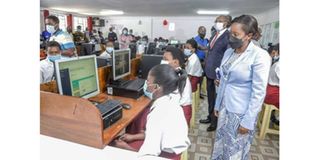More internet facilities needed to boost girls’ education during crises

ICT Chief Administrative Secretary Maureen Mbaka during an inspection tour of the computer laboratory at Sironga Girls High School in Nyamira on December 14, 2021. Ministry of ICT launched the Internet connectivity programme to facilitate and improve teaching and learning. |
What you need to know:
- In emphasis Jabulani Gwapedza, a lawyer, says grassroots advocacy would lead to more investments in girls’ education.
- FAWE Kenya chief executive officer Teresa Otieno calls on governments to fast-track their progress in achieving Sustainable Development Goal (SDG) 4 on access to quality education.
More investments in internet-enabled facilities within communities are needed to facilitate uninterrupted remote learning for girls during crises, women rights advocates have said.
In a Twitter Chat on Monday to mark International Day of Education themed “Changing Course, Transforming Education”, stakeholders delved into policy changes African governments can adopt beyond the Covid-19 pandemic to achieve a transformed education sector.
“If Africa has access to vaccination and gets herd immunity, then this will be a blessing as the virtual method of learning has proven to be a barrier for the majority of girls in Africa,” said Melissa Ruvimbo, programmes and advocacy associate at Rozaria Memorial Trust during the virtual discussion facilitated by the Forum for African Women Educationalists(FAWE)-Kenya.
Grassroots advocacy
In emphasis Jabulani Gwapedza, a lawyer, said grassroots advocacy would lead to more investments in girls’ education.
According to the Wide Web Foundation, globally, more than two billion women are offline. And even where they have access to the Internet, they are less likely than men to make full use of the opportunities associated with connectivity.
Of concern is that countries are making zero to little efforts to end the inequalities in access to and use of digital technology. A 2017 Alliance for Affordable Internet survey, which analysed 58 countries in Latin America, the Caribbean, Africa, and Asia on the existence of policies designed to encourage increased access, training and use of the Internet for women and girls proved this.
It found “very little to no discussion of the digital gender gap and possible responses to address the problem at the policy level,” in the countries.
Achieving SDG 4
Meanwhile, FAWE Kenya chief executive officer Teresa Otieno called on governments to fast-track their progress in achieving Sustainable Development Goal (SDG) 4 on access to quality education.
“With just a decade remaining to achieve SDG 4 (quality education), it is imperative that all countries have the means to monitor progress and plan necessary changes for the future,” she said.
Last year, during a United Nations forum to mark International Day of the Girl, UN Women, Strategic Partnerships Division director Daniel Seymour challenged countries to make deliberate efforts to expand women’s access to the Internet.
“We have to get to a place where access to technology is not seen as something nice to have but as a critical enabler of equality. And so, governments have to have policies to make that happen,” he said.





